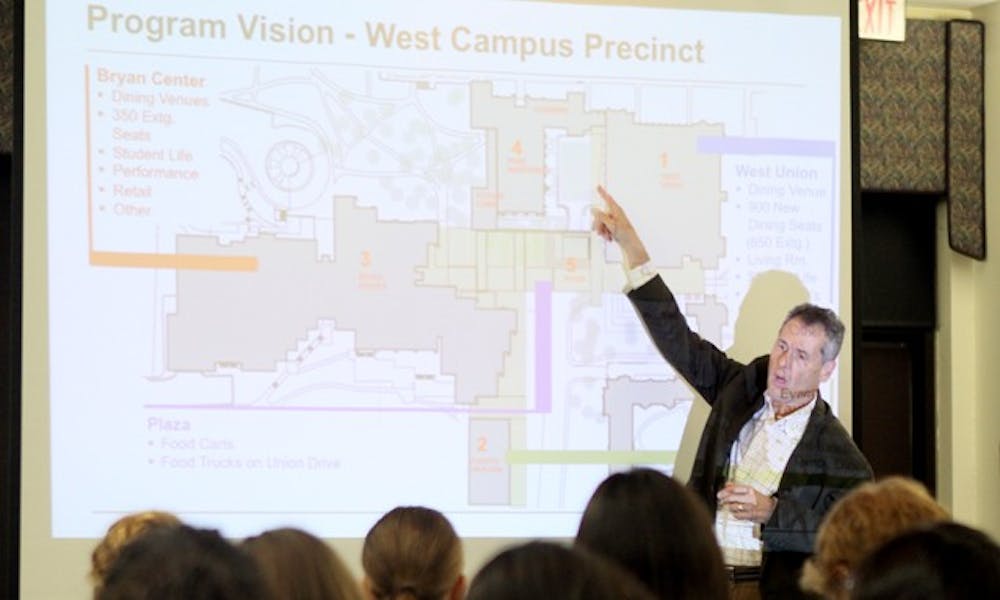Vice President for Student Affairs Larry Moneta presented an outline of the upcoming West Union building renovations to a crowd of about 40 students Thursday evening.
Moneta also fielded questions from the audience, which was made up in large part by members of the Black Student Alliance and The Chronicle, who are both key stakeholders in the renovations among other student groups.
Duke currently lacks adequate public spaces, Moneta said, adding that he intends for the renovated West Campus Precinct—what Moneta said was the combination of the West Union, the Bryan Center, Page Auditorium and an events pavilion—to serve as a collective student center along with existing spaces, such as McClendon Tower and von der Heyden Pavilion. The renovations to West Union are scheduled to begin July 2013.
“We’re always going to be a campus of niches, and we are doing our best to weave that into what might be the big student center on other college campuses,” he said.
Moneta explained the reasons for the renovation, noting the structure’s declining architectural quality. He described West Union as a “patchwork quilt of buildings” constructed at different times in the 1930s and 1950s with 16 separate mechanical systems.
“We’re really at the front end of our planning,” Moneta said. “There’s no architecture yet—all there is is conceptual planning.”
The concept designs displayed at the meeting—in part based on 35 student narratives collected during the summer—include noticeably expanded dining space under a new marche style design, Moneta said. West Union dining seats will increase from 650 to 900, with an emphasis on open, continuous spaces with self-contained restaurant units. The number of eateries will remain roughly the same.
The design was inspired in part by Chef Mario Batali’s Eataly, a city block of restaurants in New York City, Moneta noted. He added that a restaurant designer will join the design team for the project, which will be unique among college campuses.
The next three months will be devoted to planning the events pavilion, which is set to begin construction June 2012 and finish in time to close down the West Union for renovations, Moneta said. Administrators will also work with four student working groups to address the needs of groups displaced by the renovation. In particular, new locations for the Center for Lesbian, Gay, Bisexual and Transgender Life, the Mary Lou Williams Center for Black Culture and The Chronicle are yet to be determined.
Moneta noted that such student centers will likely only move once, adding that there will be two years—when West Union is being renovated—when there is simply less space on campus.
Addressing recent student criticism about the removal of the centers from the new West Union, Moneta said he is committed to the cultural groups.
“I get it, and I’m a firm believer that the centers are part of the public community,” he said. “There will not be a step back.”
Many student leaders who attended the meeting said they were pleased that Moneta gave the presentation, but they wish there had been more information about the potential location of cultural centers.
The lack of details regarding the cultural centers is not indicative of the needs of Duke students, said senior Imara Hoyte, president of the Duke branch of the National Association for the Advancement for Colored People.
“Duke has really grown to be a hub of cultural cohesiveness,” Hoyte said. “When you make a new place that affects the whole University, it needs to reflect the cultural goals.”
Sophomore Patrick Oathout, Duke Student Government senator for athletics, services and the environment, said even though there are very few details about the future of the cultural centers at this point, he is optimistic because Moneta said new locations will be an improvement no matter what.
He added that it is important that all students—not just those who belong to the various cultural space stakeholders—are able to participate in the upcoming discussions about the renovations.
“The student body is angry because they think they aren’t included—that’s why they’re mad about things like the house model,” Oathout said. “It’s because they don’t know what’s happening.”
The offices of The Chronicle in 301 Flowers will be displaced when the Flowers building and Page Auditorium renovations begin in 2015, Moneta said. The Chronicle is currently in negotiations with Student Affairs regarding the new location for the offices.
“The Chronicle is one of the largest student organizations and arguably contributes the most to campus dialogue by creating a tangible product every day,” said senior Sanette Tanaka, editor-in-chief of The Chronicle. “We are integral to this campus, and we need a space that reflects that.”
Lauren Carroll contributed reporting.
Get The Chronicle straight to your inbox
Signup for our weekly newsletter. Cancel at any time.

